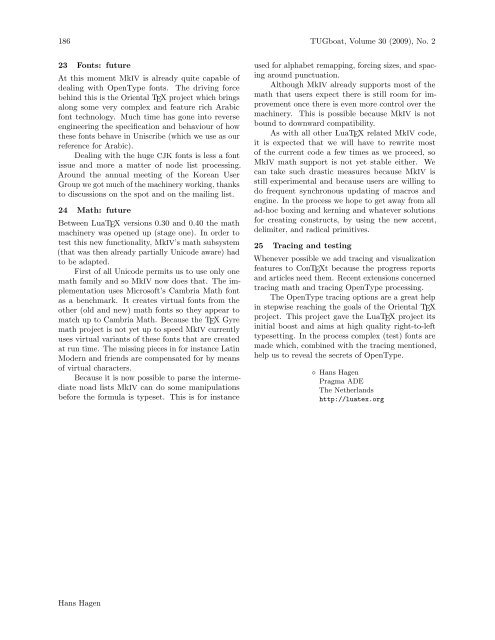The Communications of the TEX Users Group Volume 30 ... - TUG
The Communications of the TEX Users Group Volume 30 ... - TUG
The Communications of the TEX Users Group Volume 30 ... - TUG
Create successful ePaper yourself
Turn your PDF publications into a flip-book with our unique Google optimized e-Paper software.
186 <strong>TUG</strong>boat, <strong>Volume</strong> <strong>30</strong> (2009), No. 2<br />
23 Fonts: future<br />
At this moment MkIV is already quite capable <strong>of</strong><br />
dealing with OpenType fonts. <strong>The</strong> driving force<br />
behind this is <strong>the</strong> Oriental <strong>TEX</strong> project which brings<br />
along some very complex and feature rich Arabic<br />
font technology. Much time has gone into reverse<br />
engineering <strong>the</strong> specification and behaviour <strong>of</strong> how<br />
<strong>the</strong>se fonts behave in Uniscribe (which we use as our<br />
reference for Arabic).<br />
Dealing with <strong>the</strong> huge CJK fonts is less a font<br />
issue and more a matter <strong>of</strong> node list processing.<br />
Around <strong>the</strong> annual meeting <strong>of</strong> <strong>the</strong> Korean User<br />
<strong>Group</strong>wegotmuch<strong>of</strong><strong>the</strong>machineryworking, thanks<br />
to discussions on <strong>the</strong> spot and on <strong>the</strong> mailing list.<br />
24 Math: future<br />
Between Lua<strong>TEX</strong> versions 0.<strong>30</strong> and 0.40 <strong>the</strong> math<br />
machinery was opened up (stage one). In order to<br />
test this new functionality, MkIV’s math subsystem<br />
(that was <strong>the</strong>n already partially Unicode aware) had<br />
to be adapted.<br />
First <strong>of</strong> all Unicode permits us to use only one<br />
math family and so MkIV now does that. <strong>The</strong> implementation<br />
uses Micros<strong>of</strong>t’s Cambria Math font<br />
as a benchmark. It creates virtual fonts from <strong>the</strong><br />
o<strong>the</strong>r (old and new) math fonts so <strong>the</strong>y appear to<br />
match up to Cambria Math. Because <strong>the</strong> <strong>TEX</strong> Gyre<br />
math project is not yet up to speed MkIV currently<br />
uses virtual variants <strong>of</strong> <strong>the</strong>se fonts that are created<br />
at run time. <strong>The</strong> missing pieces in for instance Latin<br />
Modern and friends are compensated for by means<br />
<strong>of</strong> virtual characters.<br />
Because it is now possible to parse <strong>the</strong> intermediate<br />
noad lists MkIV can do some manipulations<br />
before <strong>the</strong> formula is typeset. This is for instance<br />
Hans Hagen<br />
used for alphabet remapping, forcing sizes, and spacing<br />
around punctuation.<br />
Although MkIV already supports most <strong>of</strong> <strong>the</strong><br />
math that users expect <strong>the</strong>re is still room for improvement<br />
once <strong>the</strong>re is even more control over <strong>the</strong><br />
machinery. This is possible because MkIV is not<br />
bound to downward compatibility.<br />
As with all o<strong>the</strong>r Lua<strong>TEX</strong> related MkIV code,<br />
it is expected that we will have to rewrite most<br />
<strong>of</strong> <strong>the</strong> current code a few times as we proceed, so<br />
MkIV math support is not yet stable ei<strong>the</strong>r. We<br />
can take such drastic measures because MkIV is<br />
still experimental and because users are willing to<br />
do frequent synchronous updating <strong>of</strong> macros and<br />
engine. In <strong>the</strong> process we hope to get away from all<br />
ad-hoc boxing and kerning and whatever solutions<br />
for creating constructs, by using <strong>the</strong> new accent,<br />
delimiter, and radical primitives.<br />
25 Tracing and testing<br />
Whenever possible we add tracing and visualization<br />
features to Con<strong>TEX</strong>t because <strong>the</strong> progress reports<br />
and articles need <strong>the</strong>m. Recent extensions concerned<br />
tracing math and tracing OpenType processing.<br />
<strong>The</strong> OpenType tracing options are a great help<br />
in stepwise reaching <strong>the</strong> goals <strong>of</strong> <strong>the</strong> Oriental <strong>TEX</strong><br />
project. This project gave <strong>the</strong> Lua<strong>TEX</strong> project its<br />
initial boost and aims at high quality right-to-left<br />
typesetting. In <strong>the</strong> process complex (test) fonts are<br />
made which, combined with <strong>the</strong> tracing mentioned,<br />
help us to reveal <strong>the</strong> secrets <strong>of</strong> OpenType.<br />
⋄ Hans Hagen<br />
Pragma ADE<br />
<strong>The</strong> Ne<strong>the</strong>rlands<br />
http://luatex.org

















